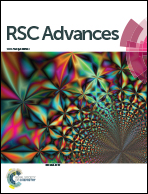Surfactant effects on the synthesis of durable tin-oxide nanoparticles and its exploitation as a recyclable catalyst for the elimination of toxic dye: a green and efficient approach for wastewater treatment
Abstract
A green synthesis of SnO2 nanoparticles was successfully developed using urea by a microwave heating method. This method resulted in the formation of spherical, microcrystalline SnO2 nanoparticles with an average size of ∼4.0 nm. The role of cationic and non-ionic surfactants, namely cetyl pyridinium chloride (CPC) and triton X-100, in the synthesis of SnO2 nanoparticles are investigated. In this reaction, surfactants act as capping agents. The addition of a surfactant along with urea leads to the formation of spherical and microcrystalline SnO2 nanoparticles. The average particle size of the CPC assisted SnO2 nanoparticles is ∼4.5 nm, while that of triton X-100 assisted SnO2 nanoparticles is ∼5.8 nm. An increase in band gap energy is observed with a decrease in particle size because of three dimensional quantum confinement effect shown by synthesized SnO2 nanoparticles in their electronic spectra. The band gap energy of SnO2 nanoparticles synthesized using urea is ∼4.30 eV, whereas that of CPC assisted SnO2 nanoparticles and triton X-100 assisted SnO2 nanoparticles are ∼4.25 and ∼4.15 eV, respectively. The synthesized SnO2 nanoparticles were characterized by transmission electron microscopy (TEM), selected area electron diffraction (SAED) and Fourier transformed infrared spectroscopy (FT-IR). The optical properties were investigated using UV-visible spectroscopy. The synthesized SnO2 nanoparticles act to be an efficient photocatalyst in the degradation of rhodamine B and methyl violet 6B dye under direct sunlight. For the first time, methyl violet 6B and rhodamine B dye were degraded by solar irradiation using SnO2 nanoparticles as catalyst.


 Please wait while we load your content...
Please wait while we load your content...